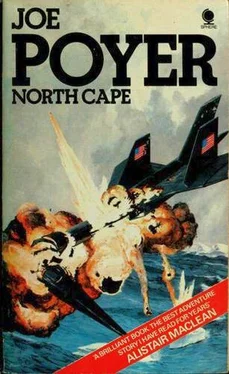The missiles fell far short, not a serious hazard after all. Teleman bent wearily forward and programed the ECM to respread the sixteen-hundred-mile safety net around the A17. The remaining three Soviet Falcons had pulled around to the north as he crossed the border, and climbing swiftly up to his altitude was a single replacement with which the Soviets would probably try and keep him in sight. But it would be a hopeless task, Teleman knew. He now had a pretty good idea of the effective range of their visual tracking gear. Five hundred miles seemed to be the ultimate, limit and accurate tracking could be performed properly only at less than four hundred miles. Accordingly, Teleman pulled into a long arc to the southwest that would bring him out of range in less than twelve minutes, and throttled back to Mach 1.9.
Two problems, both serious, still faced him. One was how to repenetrate the Soviet Union in order to make the rendezvous point on time; the second was his dwindling fuel load. Both problems were interdependent.
After fifteen minutes of intense work with the computer, Teleman sat back and studied the results. Keeping him company the entire while was the lone Falcon, six hundred miles north and safely inside his own border. Teleman was sure he was out of sight of the Soviet aircraft. He had to be in order for this new course to work. The computers, taking all the variables into account, including the fact that it was very possible for the Soviets to again pick him up deeper into the Soviet Union, had drawn a flight path that would keep him outside the boundaries of the Soviet Union until he reached the vicinity of the Caspian Sea. He would re-enter the Soviet Union from northern Iran, skirting the southern edge of the Caspian at two hundred thousand feet. He would use a full ECM range of sixteen hundred miles, as the Soviet border radar net would he on alert and it would be impossible to escape their notice anyway. It was very likely that, if they could have visual tracking systems for aircraft, then they could also have ground stations to perform the same job over a wider range and with greater accuracy. But radar disruption of sixteen-hundred-mile diameter should make it impossible for the radar net to provide enough of a course approximation to the visual tracking stations to aid in spotting him in the three minutes or so that he would be within range. Telcman fell off slowly, deeper into Afghan territory, always paralleling his original line of flight, keeping the Russian plane on the edges of his radar screen while slowly leaving him behind. The one-sided chase continued due west now, until he had left the torn earth of the Hindu Kush far behind and below lay the rugged Plateau of Iran. Every ten minutes, regular as clockwork, he watched another Falcon spiral up to take his station on the other side of the border. The A-17 was on full automatic now and Teleman was merely a passenger. At a certain point the aircraft banked steeply to the south, then steadied in response to a small correction in the flight plan. After half an hour of this blind run and chase, his, companion, now six hundred miles behind him, overstayed his ten-minute pattern. Teleman bent to the radar screen, watching to see what would happen. A minute passed, then a second and a third. In the fourth minute the Falcon slid off one wing and dropped quickly into a long glide northwest. Teleman checked his maps. The air base at Ashkhabad on the Soviet side of the Turkman SSR-Afghanistan border was now within range. Operations had probably been shifted accordingly, Teleman thought.
He turned his attention to the ground control map rolling out on the screen. His flight path was marked by a triangular bar reaching to the black horizon line. The flight path was superimposed on an actual view of the terrain below. Off his starboard wing was the Iranian city of Meshed and he knew that the Iranians had a large radar complex north of the city, watching the Russian border. His crossing point would be almost directly over the city of Babol, two hundred miles northeast of Tehran.
After this little bit of unscheduled horseplay, his’ fuel load was going to be cut mighty fine to get him to rendezvous. He would have to reduce speed severely and yet he still had to get there on time. He was certain that Larkin, from what little he knew of his contact man, could be depended on, gale or no gale. He had not received any weather reports on conditions between Greenland and Novaya Zemlya since he started his run south from the Arctic. To avoid the least possibility of detection, all but two monitoring channels were shut down automatically during the mission portion of any flight over Communist territory. The Soviets were known to monitor the Advanced SAMOS satellite system by ground and shipboard stations in an effort to break the codes used. The only weather information he could receive, then, was from the military weather satellites directly overhead, and they reported on local conditions only. Satellite-to-satellite transmissions were too easily monitored and traced to allow him to interrogate at will. Teleman could therefore only guess at weather conditions in the Arctic, and if the ice clouds that overlay most of Asia were any indication, he had to conclude that they were extremely bad.
Once more he had the computer review the flight plan for him. In twelve minutes he would be crossing the border into Soviet territory. Teleman was well aware that, if he had missed anything while setting up the course, the flight plan would end with him and the A-17 scattered across miles of steppe, rather than orbiting the Robert F. Kennedy prior to refueling for home.
After crossing the border, the flight path would take him over the southern end of the Caspian Sea to the Caucasus Mountains and across the Sea of Azov, then over the bend in the Dnieper River to bypass Kiev, and out across the Ukraine to Poland. Over the Ukraine, he had a choice to make. Depending on local weather conditions and any indications of Soviet fighter activity, he could, if he had to, drop farther south into the Czechoslovakia-Hungary region and run for West Germany and the North Sea. That alternative was his last-ditch escape attempt if they tried to intercept him over continental Russia. If not, he would make for Poland and the Baltic Sea and up across the Scandinavian Peninsula. That route would put him at the rendezvous point with ten minutes of fuel left, much more preferable than ditching in the Barents Sea. He could do the last in seven hours by holding his speed to Mach 1.5, his most economical cruising speed.
Ahead now was the Soviet border, and it was time to crank out the radar counterdetection gear. A circle of interference sixteen hundred miles across would keep them busy for a long time, hunting for him with that damned visual gear.
Larkin was on watch, strapped securely into Ms high seat, when Folsom stumbled through the Hatchway onto the bridge. Larkin nodded a greeting without taking his eyes from the violent seas visible through the revolving screen. Truly mountainous waves were building, even here in the lee of the cliffs forming the sea edge of the North Cape. Folsom, peering out through the spinning circle of glass that kept the ice and sleet from completely shrouding the bridge windows, was shocked to see just how high and rough they had become in the two hours he had been off bridge duty. In the engine room, where he had been assisting with the overhaul for the last hour, the motion of the ship had been rough, rougher than he had ever experienced that far down in the hull of any ship. But the spread of tortured wave and glooming sky through the glass was beyond belief. Folsom estimated the waves to be rising nearly eighty feet. The anemometer showed wind speed gusting to 105 knots. The sweep of horizon, broken only by the faintly visible headlands of the Cape to the extreme west, was filled with masses of cyclonic cloud that intermittently obscured frost-sharp stars, glistening momentarily overhead whenever the ship, cresting a wave, rose out of the dense spray fog. The wind-riven clouds, still low on the horizon; were bearing down savagely. In less than two hours the U.S.S. Robert F. Kennedy would reel under the impact of the storm’s major onslaught. Since early morning Folsom had been aware of a mild tension building in the pit of his stomach. Now staring through the spinning disk of glass, it threatened to choke him. He swallowed and reswallowed as inconspicuously as possible. He had been through bad gales before, but never one of such fury or with a damaged ship. For the hundredth time since the strain gauges had been installed, he leaned over to study the dials. All four gauges, their leads attached to the insides of the patch and to the hull plates, showed periodic flex that he knew would be loosening the welding beads. Earlier he had sent a crew into the hull tank to reweld the plates flush against the tank, but they had been. unable to finish more than three strengthening bars before the mounting vibration of the hull plates against the hammering of wind and wave made further work impossible.
Читать дальше












